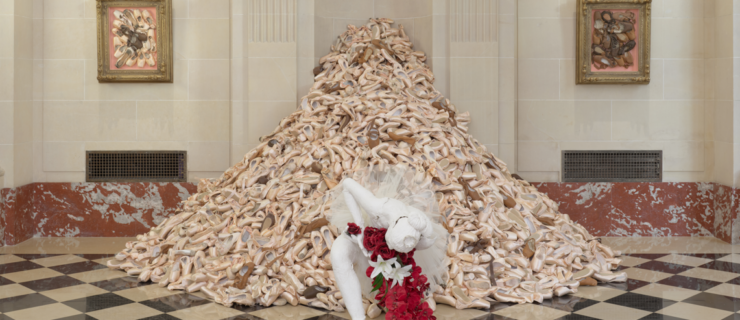River North Chicago Dance Company
River North Chicago Dance Company
The Harris Theater
Chicago, IL
February 13, 2010
Reviewed by Lynn Colburn Shapiro
Lizzie MacKenzie and Brandon DiCriscio in
Suppose by Lauri Stallings. Photo by Erika Dufour, Courtesy RNCDC.
What makes abstract dance meaningful to an audience? Captivating mood, technical virtuosity, the vicarious thrill of athletic daring, the sheer joy of dance? All of the above, if you caught River North’s 20th anniversary season.
Story or no, dance is always about something. Take Sherry Zunker’s Evolution of a Dream (2009), beginning with a dreamy sequence of bodies emerging like single-celled organisms from a primordial sea of dappled light. They wish themselves into vertebrates, sprout arms and legs, and coalesce in self-discovery. Small, broken flicks and pulses convey tentative wonder, progressing to longer, sustained phrasing and launching into group patterns that flood the stage. Solo riffs highlight technical chops while stoking the fires for a driving ensemble climax.
You can’t help feeling the dancers have a secret agenda behind the jitters and squirms of organized weirdness in Lauri Stallings’ choreographic gamelan, Suppose (a premiere). The compelling work alternately freezes, releases, and dangles body parts; catches the breath at unexpected moments; couples and separates bodies in spidery lifts and permutations of crawling. Stallings takes us to a feverish world we’d never find on any map.
In what begins like a comic exorcism, Robert Battle’s premiere, Three, creates a competitive arena for Christian Denice, Michael Gross, and Ricky Ruiz. Body isolations build breathtaking solos and duets, as if for an Olympic-scale event. The movement plays with vocal percussion, car noises, and drums (by Eleventh Hour, Art of Noise, Taiko Drums, and Les Tambours Du Bronx). Moments of stillness and flow interrupt relentless percussive intensity, until the dance careens like screeching tires into blackout.
Every inch of Lauren Kias’ body ricocheted off Ella Fitzgerald’s infectious scat singing in Battle’s Ella (2007). But the vast Harris Theater swallowed up a good measure of this tour de force solo, which plays better in a smaller house. Jordan Ross’ black costuming against a black backdrop didn’t help, and the piece never developed beyond its initially marvelous concept.
Jackson Lowell’s inspired costumes double as props in artistic director Frank Chaves’ Forbidden Boundaries (2009), a stunning full-company piece. In the opening moments, the dancers hang onto each other’s gauzy jackets, creating a geometry of interlocking nets. Once released, the jackets flow like wings, contrasting freedom with dependence. Chaves gives Michael Gross, Lizzie MacKenzie, and Ruiz a striking trio with the men holding MacKenzie’s “wings,” so that only her legs can move. They use the jacket to wrap her up, swing and fly her, drag her limp, and finally let her go. Once free, she wraps herself in the garment, exhausted, and exits through the ensemble’s surge back onstage. Lyricism gives way to conflict between couples in part four. Ultimately a tribal solidarity emerges in group vocalizations, with the company lined up across the proscenium, thrusting their jackets to the floor in a final, defiant beat.
Rounding out the program were reprises from last season’s Tuscan Rift, also by Chaves; Monique Haley’s slick and sassy dance party, Uhuru; and Chaves’ valentine, Sentir Em Nos, for Gross and Melanie Menale-Hortin, whose interpretations, more mature than before, give this slice of passion the sizzle it deserves.



